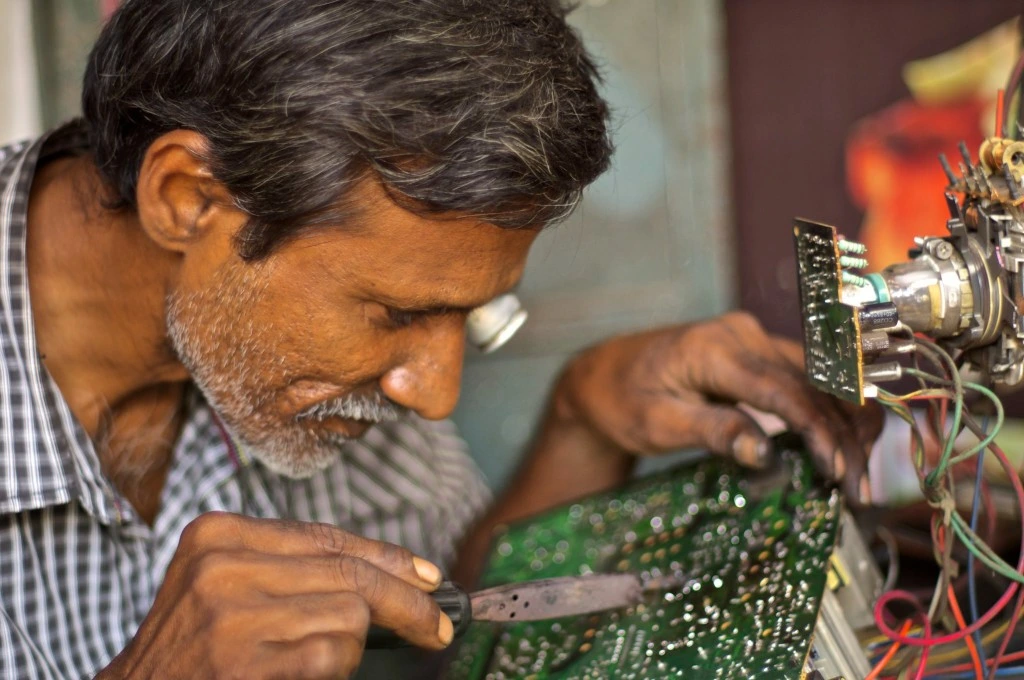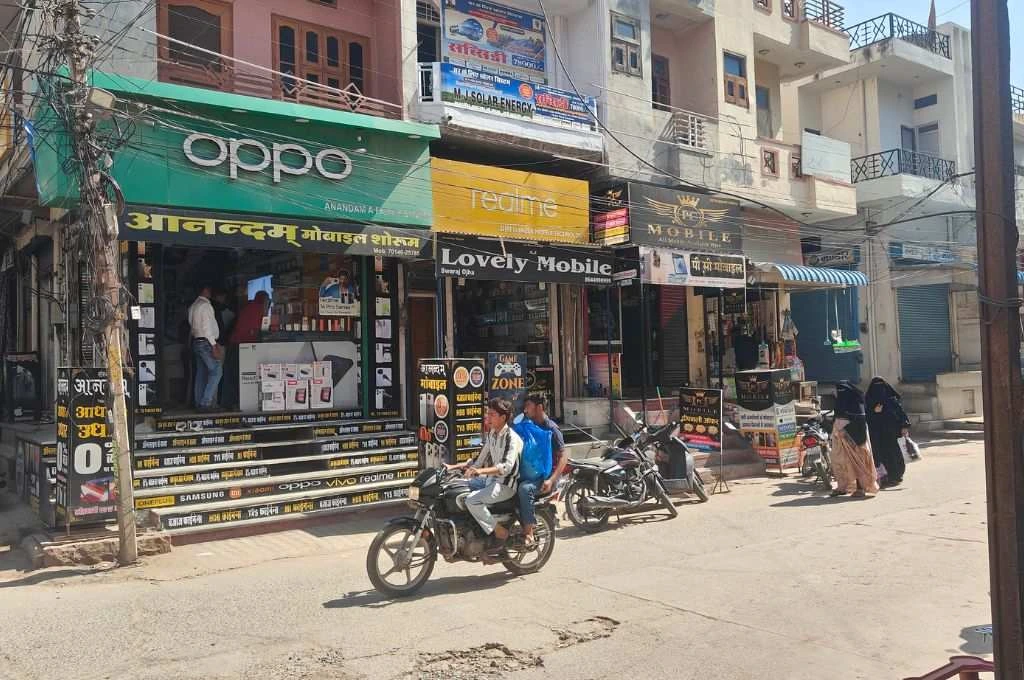The idea of a circular economy for electronic devices is gaining global currency. India, for one, already has an ecosystem of neighbourhood shops that offer repair, reuse, and recycling options for these devices. However, such outfits are conspicuously absent from the country’s sustainability narrative.
According to a 2024 report by United Nations Trade and Development (UNCTAD), India’s waste from computers, smartphones, and small IT devices grew by 163 percent between 2010 and 2022—the highest growth rate in the world. It is becoming increasingly difficult to competently manage the burgeoning electronics refuse. Meanwhile, repair shops, resellers, and informal e-waste businesses, which could help address a significant part of this challenge, are yet to find their proper place in the solution strategy.
During the IT boom in the 1990s and 2000s, computer and mobile repair shops mushroomed across the country. However, in recent years, these stores have struggled to stay relevant.
Consumers are moving to disposable tech
Ashok Bhushan has worked as a technician at Computer Comrades, a computer repair and reselling shop at Nehru Place, a repair hub New Delhi, for close to three decades. He observes that consumers now aspire to own the next new gadget and don’t care as much about making the current one last. “People want trendy technology. They buy cheap computers that stop functioning within a couple of years.”
On top of that companies are also manufacturing products that are not conducive to repair. Chandrakant, who runs Balaji Computers—an electronics repair shop in Churu, Rajasthan—says, “Most laptops are now built as disposable products.” The situation is the same for premium smartphones, which are notorious for being difficult to repair.
It’s tough to keep pace with e-commerce platforms
While fewer customers are opting for repair, those who do often turn to e-commerce platforms such as Urban Company and Cashify instead of local shops. Swaraj Ojha, owner of Lovely Mobile in Churu, says that e-commerce giants attract customers with unfair discounts and deals. He adds, “The government should intervene and enforce fair pricing so that shops like ours can compete on a level playing field.”
Divya Tiwari, from Saahas—an organisation that works on solid waste management—believes that greater visibility for local shops could give them some leverage. She says, “Repair shops need to be listed on Google Maps with their contact details. Increased visibility and accessibility will bring them more business. Government and CSR funds could be deployed to enable support this activity.”
Some repair shops have tried this, but with limited success.
Computer Comrades listed itself on Justdial and was overwhelmed with calls. Ashok says, “We were receiving thousands of calls at all hours. Our customer base did grow, but we didn’t know whether to fix computers or to answer the phone. Once a customer called me at 2 am asking if the shop would be open the next day. It was maddening.”
Prices plummet because of competition
Customers looking for repair stores online pick the ones with the cheapest quote. Ashok reveals, “We kept lowering our prices until we realised that was not a sustainable way to run the business.” Establishments in smaller cities, such as Balaji Computers and Lovely Mobile, face the double challenge of competing with both e-commerce platforms and electronic repair hubs in Jaipur and Delhi, which advantage from scale.
In a Saahas survey conducted in Bengaluru, repair shop owners reported that customers trusted the manufacturing companies’ service centres more and were even willing to pay these brands for extended product warranties. Ashok says, “Recently, a nonprofit suggested that we increase customer retention by offering an extended warranty on products. But no one wanted to pay us extra money, and it was driving customers away.”
Most shop owners say that the industry is becoming increasingly unpredictable, with neither customer demand nor technology following a clear pattern.

Upskilling is expensive
Rajesh, who runs The Mobile Store in Agartala, Tripura, says, “The repair process for newer smartphones is more complex. You need specialisation for each part. Someone who knows how to fix the display might know nothing about the CPU.” Rajesh learned mobile repair from his brother, who studied hardware in the mid 90s. He says, “I upgraded my skills through videos on Facebook and YouTube.” Ashok, who secured a diploma in hardware engineering when he started working in the late 90s, adds, “We need practical knowledge to upskill, but there are no programmes to keep us updated.”
Divya highlights the need for manufacturing companies to play a more active role in this area. “The government could set refurbishing targets for smartphone manufacturers. The onus of continuous training for the technicians should also be on them. Different brands could even come together to establish skilling centres across the country.”
Rajesh shares that while some customers come to him with a broken smartphone display or a malfunctioning battery, he doesn’t have the equipment to fix a damaged CPU or recover data in case of memory failures. He explains, “I sent my brother-in-law for a training course on CPUs in Nagpur. But I will have to invest in an assembly machine, a new microscope, and other equipment. It will be an investment of INR 2–3 lakh, and I’m not sure we can recover the cost.” Divya notes that it is hard for individual repair shops to keep pace at that scale.
It is a vicious cycle. While repair shops can’t afford the training and equipment to work with the latest technology, more and more phones and laptops end up as waste in the informal sector, which has its own set of issues.
Recycling is a risky business
Behind the bustling Nehru Place electronics market, there are scrap shops that receive obsolete and damaged gadgets, which they dismantle and sell to other scrap vendors. Most of these shops are licensed, family-run businesses, but they know very little about the larger e-waste ecosystem. A vendor, requesting anonymity, elaborates, “We buy based on weight and sell to dealers who melt the metals. The newer gadgets weigh less, so there is less money. But this is the only work I have ever done.”
Studies show that approximately 90 percent of India’s e-waste is processed by the informal sector. Divya further contextualises, “Even waste from the formal sector, where recyclers are licensed by the government, spills into the informal sector due to poor monitoring and high levels of corruption.” She adds, “Much of this refuse ends up in areas such as Seelampur and Moradabad, where workers operate in unsafe conditions and sometimes employ child labour as well.”
India has had laws governing the collection and processing of e-waste since 2011. The rules have undergone several amendments and revisions over the years, with the latest in 2024. However, while the registration process is robust for formal sector recyclers, little has been done towards formalising the informal space.

Divya recommends e-waste parks with common physical and administrative infrastructure to improve compliance and help informal e-waste workers sustain their livelihoods. “The government could create such parks in places like Seelampur and Moradabad, where various units from the informal sector can function.”
In addition, Divya emphasises that e-waste should be reduced with a policy focus on refurbishing devices and parts. “India has a large, upwardly mobile demographic interested in refurbished products if their quality is good.” She also stresses the need for a better manufacturing process and urges the electronics industry to adopt a closed-loop recycling process—where at least some parts of a product can be reused to build newer gadgets or extend the life of old ones. “Like countries in the European Union, we should push brands to design products that don’t create a pile-up of waste at the end of their life.”
There is a market for refurbished electronics
There are ample opportunities in the refurbished electronics space in India. According to a 2024 study, the used phone market in India is growing at a faster rate than the new phone market. Tier-II and -III cities, such as Agartala and Churu, are witnessing increasing demand for electronic devices. Chandrakant says, “Our primary customers are young people in Churu who need them for education, work, and entertainment. Their purchasing power is lower compared to many people living in bigger cities.”
There’s demand for used tech in Delhi too, but for a different set of consumers. Ashok explains that many private companies buy used computers from them.
Neighbourhood shops fulfil an important need
Private companies are also among Ashok’s most loyal consumers for repair services. “Most of our regulars want to extend the lifespan of their devices,” he says.
Many of these shops have been in the same location for years and have earned the trust of their customers. They believe that intangibles like reliability and human interaction give them an edge over their competition.
For example, Rajesh’s shop in Agartala is frequented more by individuals who find the online process for replacement and repair complicated. Similarly, Swaraj says that in Churu, smaller shops like his are trusted by locals because they provide persona; interactions that online media cannot.
But as technology catches up and consumer convenience takes precedence, goodwill and trust-based relationships might not be enough for survival.
Saloni Meghani also contributed to this article.
—
Know more
- Read this article to learn about the environmental value of repair work in India.
- Learn about circular economy and why it is important for India’s sustainability goals.
- Explore the findings from this study on India’s second-hand smartphone market.







